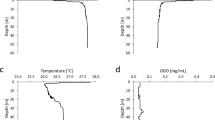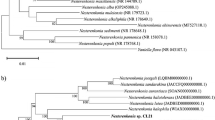Abstract
New alkaliphilic anaerobic fermentative bacteria, strains Z-7981 and Z-7981′, with Gram-positive cell walls, were isolated from the cellulolytic community from the soda lake Nizhnee Beloye, south-east of Baikal. Cells were motile rods, which differed in dimensions but, according to 98% DNA/DNA homology, belonged to the same species. Strain Z-7981 was chosen as the type and studied in detail. It did not produce spores and its cells were non-thermoresistant. It was a true alkaliphile with a growth range from pH 7.1 to pH 10.1 and optimal pH for growth at pH 9.1. It was obligately dependent on Na+ and carbonate ions but not on Cl−. Growth occurred in media with total sodium content from 0.076 M to 1.27 M Na+ with a broad optimum from 0.25 to 0.86 M Na+. Growth showed an optimum at 35°C, with absence of growth above 46°C. The organism was aerotolerant and was capable of fermentation in non-reducing medium at less than 4.75% O2 in the gas phase. Strain Z-7981 fermented mono- and disaccharides, sugar alcohols, but only glutamate and cysteine among the amino acids, and the proteinaceous substrates, chitin and dried Spirulina biomass. Fermentation products were acetate and ethanol. Fe3+ was reduced in a process that yielded no energy. Phylogenetically the new organism belonged to cluster XI of the Gram-positive bacteria with low G+C content and its closest neighboring taxon was Tindallia magadiensis. However, according to its phenotypic and genotypic characters it did not belong to any known genus from this group. We suggest a new genus and species with the name Anoxynatronum sibiricum and strain Z-7981 as its type (=DSM15060).




Similar content being viewed by others
References
Collins MD, Lawson PA, Willems A, Cordoba JJ, Fernandez-Garayzabal J, Garcia P, Cia J, Hippe H, Farrow JAE (1994) The phylogeny of the genus Clostridium: proposal of five new genera and eleven new species combination. Int J Syst Bacteriol 44:812–826
De Ley J, Cattoir H, Reynaerts A (1970) The quantitative measurement of DNA hybridization from renaturation rates. Eur J Biochem 12:133–142
Felsenstein J (1990) PHYLIP Manual Version 3.3. University Herbarium, University of California, Berkeley, CA
Gorlenko VM, Namsaraev BB, Kurylova AV, Zavarzina DG, Zhilina TN (1999) The activity of sulfate-reducing bacteria in bottom sediments of soda lakes of the Southeastern Transbaical Region (in Russian). Microbiologiya 68:580–585
Hanson R, Phillips J (1981) Chemical composition of the bacterial cell. In: Gerhardt P (eds) Manual of methods for general bacteriology. American Society of Microbiology, Washington: transferred under the title Methody obsshchei bakteriologii, Mir, Moscow (1984), pp 295–297
Jones BE, Grant WD, Duckworth AW, Owenson GG (1998) Microbial diversity of soda lakes Extremophiles 2:191–200
Kevbrin VV, Zavarzin GA (1992) Effect of sulfur compounds on the growth of the halophilic homoacetic bacterium Acetohalobium arabaticum (in Russian). Microbiologiya 61:563–567
Kevbrin VV, Zhilina TN, Rainey FA, Zavarzin GA (1998) Tindallia magadii gen. nov., sp. nov.: an alkaliphilic anaerobic ammonifier from soda lake deposits. Curr Microbiol 37:94–100
Kevbrin VV, Zhilina TN, Zavarzin GA (1999) Decomposition of cellulose by an alkaliphilic anaerobic community (in Russian). Microbiologiya 68:686–695
Kulyrova AV (1999) The effect of the environmental conditions on the distribution and activity of microorganisms in soda lakes of the Southern Transbaikal region. Cand Sci (Biol) dissertation, Ulan-Ude
Lane DJ (1991) 16S/23S rRNA sequencing. In: Stackebrandt E, Goodfellow M (eds) Nucleic acid techniques in bacterial systematics. Wiley, New York, pp 115–147
Marmur JA (1961) Procedure for the isolation of deoxyribonucleic acid from microorganisms. J Mol Biol 3:208–218
Novikov YV, Lastochkina KO, Boldina ZN (1990) Methods for determining water-body quality (in Russian). Meditsina, Moscow
Pfennig N, Wagener S (1986) An improved method of preparing wet mounts for photomicrographs of microorganisms. J Microbiol Methods 4:303–306
Reed RH, Borowitzka LJ, Mackay MA, Chudek JA, Foster R, Warr SCR, Moore DJ, Stewart WDP (1986) Organic solute accumulation in osmotically-stressed cyanobacteria. FEMS Microbiol Rev 39:51–56
Sanger F, Nicklen S, Coulson AR (1977) DNA sequencing with chain-terminating inhibitors. Proc Natl Acad Sci USA 84:5463–5467
Takai K, Moser DP, Onstott TC, Spoelstra N, Pfiffner SM, Dohnalkova A, Fredrickson JK (2001) Alkaliphilus transvaalensis gen.nov., sp.nov., an extremely alkaliphilic bacterium isolated from a deep South African gold mine. Int J Syst Evol Microbiol 51:1245–1256
Tourova TP, Garnova ES, Zhilina TN (1999) Phylogenetic diversity of alkaliphilic anaerobic saccharolytic bacteria isolated from soda lakes (in Russian). Microbiologiya 68:615–622
Trüper HG, Schlegel HG (1964) Sulfur metabolism in Thiorhodaceae. Quantitative measurements on growing cells of Chromatium okenii. Antonie van Leeuwenhoek 30:225–238
Van de Peer Y, De Wachter R (1994) TREECON for Windows: a software package for the construction and drawing of evolutionary trees for the Microsoft Windows environment. Comput Appl Biosci 10:569–570
Wolin EA, Wolin MJ, Wolfe RS (1963) Formation of methane by bacterial extracts. J Biol Chem 238:2882–2886
Zhilina TN, Zavarzin GA, Rainey FA, Kevbrin VV, Kostrikina NA, Lysenko AM (1996) Spirochaeta alkalica sp. nov., Spirochaeta africana sp. nov., and Spirochaeta asiatica sp. nov., alkaliphilic anaerobes from the continental soda lakes in Central Asia and East African Rift. Int J Syst Bacteriol 46:305–312
Zhilina TN, Detkova EN, Rainey FA, Osipov GA, Lysenko AM, Kostrikina NA, Zavarzin ZA (1998) Natronoincola histidinovorans gen.nov., sp.nov., a new alkaliphilic acetogenic anaerobe. Curr Microbiol 37:177–185
Zhilina TN, Garnova ES, Tourova TP, Kostrikina NA, Zavarzin GA (2001a) Halonatronum saccharophilum gen.nov., sp.nov.: a new haloalkaliphilic bacterium of the order Haloanaerobiales from lake Magadi (in Russian). Microbiologiya 70:64–72
Zhilina TN, Garnova ES, Tourova TP, Kostrikina NA, Zavarzin GA (2001b) Amphibacillus fermentum sp.nov. and Amphibacillus tropicus sp.nov., new alkaliphilic, facultatively anaerobic bacilli from lake Magadi (in Russian). Microbiologiya 70:711–722
Acknowledgments
This work was supported by the Russian Foundation for Basic Research (project nos. 02-04-48-286 and 02-04-48-112) and by the Federal State Scientific and Technical Program "Biodiversity". The authors thank Prof. G.A. Zavarzin for useful discussions and N.A. Kostrikina for electron microscopy pictures.
Author information
Authors and Affiliations
Corresponding author
Rights and permissions
About this article
Cite this article
Garnova, E.S., Zhilina, T.N., Tourova, T.P. et al. Anoxynatronum sibiricum gen.nov., sp.nov. alkaliphilic saccharolytic anaerobe from cellulolytic community of Nizhnee Beloe (Transbaikal region). Extremophiles 7, 213–220 (2003). https://doi.org/10.1007/s00792-002-0312-5
Received:
Accepted:
Published:
Issue Date:
DOI: https://doi.org/10.1007/s00792-002-0312-5




